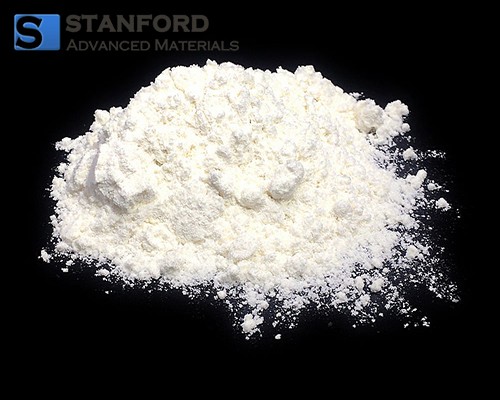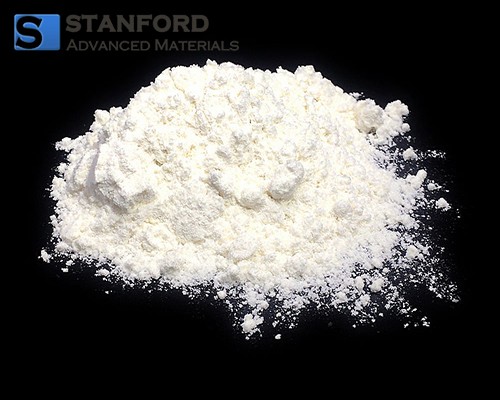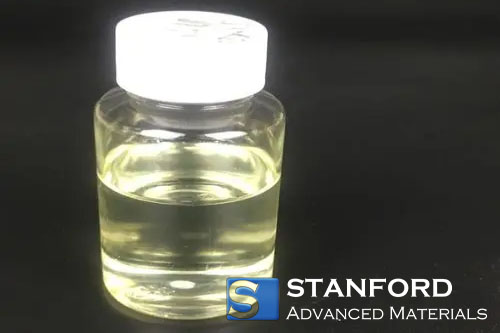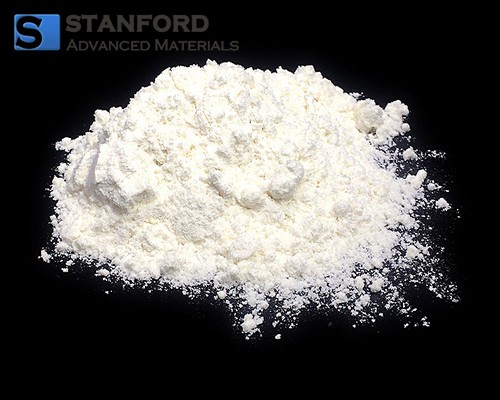SECTION 1. IDENTIFICATION
Product Name: Lithium bis(fluorosulfonyl)imide
CAS #: 171611-11-3
Relevant identified uses of the substance: Scientific research and development
Supplier details:
Stanford Advanced Materials
E-mail: sales@samaterials.com
Tel: (949) 407-8904
Address: 23661 Birtcher Dr., Lake Forest, CA 92630 U.S.A.
SECTION 2. HAZARDS IDENTIFICATION
Classification of the substance or mixture
GHS Classification in accordance with 29 CFR 1910 (OSHA HCS)
Acute tox., oral (Category 3) H301
Serious eye dam. (Category 1) H318
GHS Label elements, including precautionary statements
Pictogram
Signal word
Danger
Hazard statements
H301
Toxic if swallowed
H318
Causes serious eye damage
H333
May be harmful if inhaled
Precautionary statement(s)P261
Avoid breathing dust/fume/gas/mist/vapors/spray.
P264
Wash hands thoroughly after handling.
P270
Do not eat, drink or smoke when using this product.
P271
Use only outdoors or in a well-ventilated area.
P280
Wear protective gloves/protective clothing/eye protection/face protection.
P301 + P310
IF SWALLOWED: Call a poison venter or doctor/physician if you feel unwell.
P301 + P330 + P331
IF SWALLOWED: Rinse mouth. Do NOT induce vomiting.
P303 + P361 + P353
IF ON SKIN (or hair): Remove/Take off immediately all contaminated clothing.
Rinse skin with water/shower.
P304 + P312
IF INHALED: Call a poison center or doctor/physician if you feel unwell.
P304 + P340
IF INHALED: Remove victim to fresh air and rest in a position comfortable for breathing.
P305 + P351 + P338
IF IN EYES:
Rinse cautiously with water for several minutes. Remove contact lenses, if present and easy to do.
Continue rinsing.
P312
Call a poison center or doctor/physician if you feel unwell.
P321
Specific treatment (see specific treatment on this label)
P330
Rinse mouth.
P337 + P313P
If eye irritation persists: Get medical advice/attention
P405
Store locked up.
P501
Dispose of contents/container in accordance with local/regional/national/international regulation.
SECTION 3. COMPOSITION/INFORMATION ON INGREDIENTS
Lithium bis(fluorosulfonyl)imide
CAS# 171611-11-3
SECTION 4. FIRST AID MEASURES
Description of first aid measures
General advice
Consult a physician. Show this safety data sheet to the doctor in attendance.
Move out of dangerous area.
If inhaled
If inhaled, move person into fresh air. If not breathing, give artificial respiration.If breathing becomes difficult, consult a physician and provide oxygen.
In case of skin contact
Wash skin with soap and copious amounts of water for at least 15 minutes.
Remove contaminated clothing and shoes.
In case of eye contact
Flush eyes with copious amounts of water for at least 15 minutes.
Assure adequate flushing by separating the eyelids with fingers. Consult a physician.
If swallowed
Do NOT induce vomiting.
Never give anything by mouth to an unconscious person.
If person is conscious, rinse mouth with water. Consult a physician.
Most important symptoms and effects, both acute and delayed
The most important known symptoms and effects are described in the labeling (see Section2)
and/or in Section 11.
SECTION 5. FIREFIGHTING MEASURES
Extinguishing media
Suitable extinguishing media
Use water spray, alcohol-resistant foam, dry chemical or carbon dioxide.
Special hazards arising from the substance or mixture
No data available.
Advice for firefighters
Wear self-contained breathing apparatus and protective clothing to prevent contact with skin and
eyes for firefighting if necessary.
Further information
No data available.
SECTION 6. ACCIDENTAL RELEASE MEASURES
Personal precautions, protective equipment and emergency procedures
Use personal protective equipment. Avoid breathing vapors, mist or gas. Ensure adequate
ventilation. Evacuate personnel to safe areas.
Environmental precautions
Prevent further leakage or spillage if safe to do so. Do not let product enter drains. Discharge into
the environment must be avoided
Methods and materials for containment and cleaning up
Sweep up. Keep in a suitable, closed container for disposal.
Reference to other sections
For disposal see section 13.
SECTION 7. HANDLING AND STORAGE
Precautions for safe handling
Avoid contact with skin and eyes. Avoid inhalation of powder. Normal measures for preventive fire
protection.
For precautions see section 2.
Conditions for safe storage, including any incompatibilities
Keep container tightly closed in a dry and well-ventilated place.
Store under inert gas.Specific end use(s)
Apart from the uses mentioned in section 1 no other specific uses are stipulated
.
SECTION 8. EXPOSURE CONTROLS/PERSONAL PROTECTION
Components with workplace control parameters
Contains no substances with occupational exposure limit values
Biological occupational exposure limits
No data available
Appropriate engineering controls
Handle in accordance with good industrial hygiene and safety practice. Wash hands at minimum
before breaks and at the end of workday.
Personal protective equipment
Eye/face protection
Wear chemical safety glasses.
Use equipment for eye protection tested and approved under appropriate government standards such
as NIOSH (US) or EN 166(EU).
Skin protection
Handle with chemical safety gloves. Gloves must be inspected prior to use. Use proper glove
removal technique (without touching glove's outer surface) to avoid skin contact with this product.
Dispose of contaminated gloves after use in accordance with applicable laws and good laboratory
practices. Wash and dry hands.
Body Protection
Wear appropriate protective clothing.
Respiratory protection
Where risk assessment shows respirators are appropriate, wear full face respirator with appropriate
air-purifying cartridges. Use of materials and components tested and approved by NIOSH and CEN
(EU)
Control of environmental exposure
Prevent further leakage or spillage if safe to do so. Do not let product enter drains.
SECTION 9. PHYSICAL AND CHEMICAL PROPERTIES
Information on basic physical and chemical properties
Appearance
Form: Solid, powder
Color: White
Odor
no data available
Odor threshold
no data available
pH
no data available
Melting point
127 -135 °C
Initial boiling point and boiling range
no data available
Flash point
no data available
Evaporation rateno data available
Flammability (solid, gas)
no data available
Upper/lower flammability or explosive limits
no data available
Vapor pressure
no data available
Vapor density
no data available
Relative density
no data available
Water solubility
Soluble in water
Partition coefficient: n-octanol/water
no data available
Auto-ignition temperature
no data available
Decomposition temperature
no data available
Viscosity
no data available
Explosive properties
no data available
Oxidizing properties
no data available
Molecular formula
F2NO4S2Li
Molecular weight
187.07 g/mol
Other safety information
No data available
SECTION 10. STABILITY AND REACTIVITY
Reactivity
No data available.
Chemical stability
Stable under recommended storage conditions.
Possibility of hazardous reactions
No data available.
Conditions to avoid
No data available.
Incompatible materials
Strong acids.
Hazardous decomposition products
Hazardous decomposition products formed under fire conditions. nitrogen oxides, sulfur oxides,
hydrogen fluoride.
SECTION 11. TOXICOLOGICAL INFORMATION
Information on toxicological effectsThe toxicological properties have not been thoroughly investigated.
Acute toxicity
No data available
Skin corrosion/irritation
No data available
Serious eye damage/eye irritation
No data available
Respiratory or skin sensitization
No data available
Germ cell mutagenicity
No data available
Carcinogenicity
No data available
Chronic exposure
IARC
No component of this product present at levels greater than or equal to 0.1% is identified as probable,
possible or confirmed human carcinogen by IARC.
ACGIH
No component of this product present at levels greater than or equal to 0.1% is identified as a
carcinogen or potential carcinogen by ACGIH.
NTP
No component of this product present at levels greater than or equal to 0.1% is identified as a known
or anticipated carcinogen by NTP.
OSHA
No component of this product present at levels greater than or equal to 0.1% is identified as a
carcinogen or potential carcinogen by OSHA.
Reproductive toxicity
No data available
Specific target organ toxicity -single exposure
Inhalation
May be harmful if inhaled. Material may be destructive to the tissue of the mucous membranes and
upper respiratory tract.
Skin
no data available
Eyes
May cause eye burns.
Ingestion
May be toxic if swallowed. May cause burns.
Specific target organ toxicity -repeated exposure
No data available
Aspiration hazard
No data available
Additional Information
No data available
SECTION 12. ECOLOGICAL INFORMATION
Toxicity
No data available-An environmental hazard cannot be excluded in the event of unprofessional
handling or disposal.
Do not discharge into sewer or waterways.
Persistence and degradability
No data availableBioaccumulative potential
No data available
Mobility in soil
No data available
Results of PBT and vPvB assessment
No data available
Other adverse effects
No data available
SECTION 13. DISPOSAL CONSIDERATIONS
Waste treatment methods
Product
Observe all federal, state, and local environmental regulations. Contact a licensed professional
waste disposal service to dispose of this material. Dissolve or mix the material with a combustible
solvent and burn in a chemical incinerator equipped with an afterburner and scrubber.
Contaminated packaging
Dispose of as unused product.
SECTION 14. TRANSPORT INFORMATION
IATA
UN-Number: 3288
Class: 6.1
Packing group: III
Proper shipping name: Toxic solid, inorganic, n.o.s(Lithium bis(fluorosulfonyl)imide)
SECTION 15. REGULATORY INFORMATION
OSHA Hazards
Toxic by ingestion
DSL Status
This product contains the following components that are not on the Canadian DSL nor NDSL lists.
CAS-No. 171611-11-3, Lithium bis(fluorosulfonyl)imide
SARA 302 Components
SARA 302: No chemicals in this material are subject to the reporting requirements of SARA Title III,
Section 302.
SARA 313 Components
SARA 313: This material does not contain any chemical components with known CAS numbers that
exceed the threshold (De Minimis) reporting levels established by SARA Title III, Section 313.
SARA 311/312 Hazards
Acute Health Hazard
Massachusetts Right To Know Components
No components are subject to the Massachusetts Right to Know Act.
Pennsylvania Right To Know Components
Lithium bis(fluorosulfonyl)imide CAS-No. 171611-11-3
New Jersey Right To Know Components
Lithium bis(fluorosulfonyl)imide CAS-No. 171611-11-3
California Prop. 65 Components
This product does not contain any chemicals known to State of California to cause cancer, birth, orany other reproductive defects.
SECTION 16. OTHER INFORMATION
Safety Data Sheet according to Regulation (EC) No. 1907/2006 (REACH). The above information is
believed to be correct but does not purport to be all inclusive and shall be used only as a guide. The
information in this document is based on the present state of our knowledge and is applicable to the
product with regard to appropriate safety precautions. It does not represent any guarantee of the
properties of the product.












 GHS05
GHS05